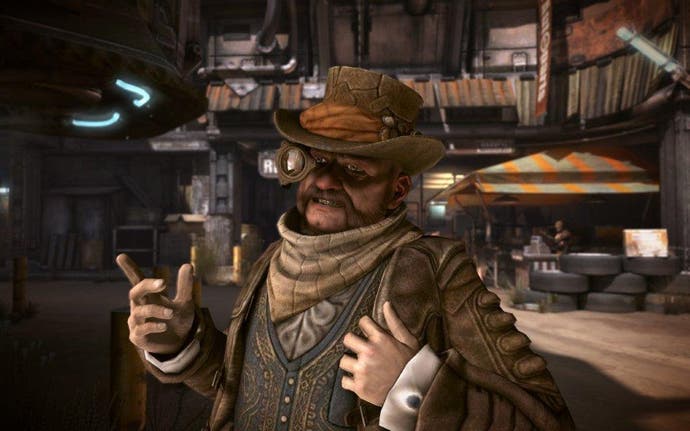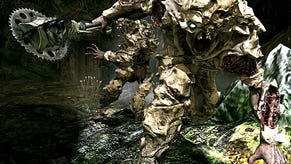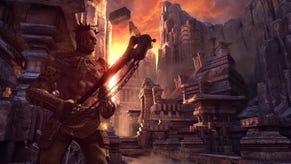Rage
Ark and ride.
It makes artists out of decorators and they live up to that burden, because many of their creations deserve the technology that lets you explore them in an unbroken stream of 60 frames per second. Wellspring, the first of two hub towns that form the backbone of your adventures, is a rusting, leaky patchwork of a community, full of little details that elevate it beyond the functionality that it represents, like cloth-bound steam pipes and settlers playing holographic dice games.
The locations you visit on missions are frequently just as memorable, like the Dead City - a misty, crumbling implosion of fractured concrete and skyscrapers piercing one another to create labyrinthine deathtraps, stalked by mutants and occasionally shaken into further disrepair by the footsteps of god-knows-what in the distance. Even the little shacks and craters you travel to for one-offs in the wasteland are warmingly characterful, like the sheer, iridescent violet chasms of the meteor impact site or the weird underground laboratory of a helpful old hermit.
The technology isn't perfect, mind you. There's a noticeable degree of pop-in as you sprint into new locations, alleviated somewhat by installing to your hard disk but disruptive all the same. This isn't a hugely interactive world either - perhaps the price you pay for so much fidelity - and so that in-jokey photo frame of creative director Tim Willits you found on a desk in Dead City isn't going to fall to the ground when you whack it with the butt of your rifle.
The knee-high piles of rubble at the extremities of your path are often invisible walls and rarely obstacles to be vaulted in search of a bonus, too, but then Rage has plenty of other secrets. There are shrines to old id Software games to uncover, collectable bobble-heads and even a trio of goalposts through which to propel your avatar by crashing your buggy and flying through the windscreen.
The driving side of Rage is at its best in the campaign when you're just tearing through the wasteland shooting bandit buggies and uncovering unique jumps. There are various races to undertake in each hub town, but the AI struggles to keep up or spams you with rockets, which leeches a lot of the fun out of proceedings.

It's a different matter online, though, where the competitive racing modes should be good for hours of entertainment. Usually built around racing to checkpoints or gathering objects while tussling with machineguns and homing rockets, they're frantic and frequently hilarious battles that make the most of the rugged, intricate terrain and bouncy, playful handling. As you level up through repeated play you can change your loadouts and customise your ride, too.
There's no competitive first-person shooter multiplayer, but elsewhere there are nine Legends of the Wasteland co-operative missions for two people, most of which repurpose locations from the campaign in new configurations, changing a route here or adding a new section there. The balance of play is different to playing alone - there's a preselected arsenal and wider arenas of combat to contend with and less emphasis on looting - but does a good job of complementing it.
Rage is a strange game in many respects, and in contrast to early id games sometimes it makes you feel like you're staring into the past rather than the future. Easily its biggest flaw is the reliance on manual saving, so you have to teach yourself to dive into the menus to record your progress every few minutes or you will probably end up replaying half an hour of content sooner or later. There's a neat defibrillator mini-game to save your life once every six minutes if you get into trouble, but it won't catch you every time.

For some, it will all add up to a strangely shallow experience, where the story never asserts itself enough to feel less than periphery, and where things we take for granted nowadays have been ignored or forgotten. This certainly isn't a video game like the ones we're used to playing in 2011, smothered in celebrity voice actors and shoulder-grabbingly intense expository cut-scenes, and varnished by psychologists so we never look in the wrong direction when we're sprinting away from a set-piece. Instead it's something simpler and more old-fashioned.
Judged on game design and content, then, it's slightly anachronistic, but as a toy box full of things you can only do in games, Rage is warm-hearted and refreshing. It's not going to change the world, but it does serve as a timely reminder of that other thing id Software games always did besides smashing through some new technological barrier. They made shooting things fun, and it's nice to have that back.








